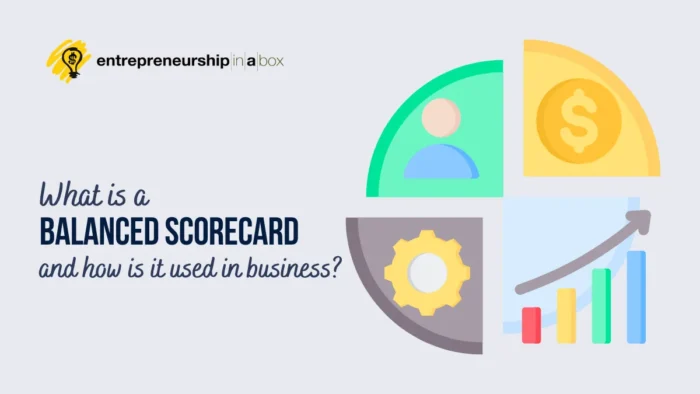The Balanced Scorecard (BSC) is a strategic management system that helps organizations align their activities with their strategic goals. It provides a comprehensive framework for measuring and managing performance across multiple dimensions, including financial, customer, internal business processes, and learning and growth.
This article will explore the critical components of the balanced scorecard approach and provide insights into how organizations can effectively utilize it as a strategic management system.
The Balanced Scorecard is a Management System for Improving Performance
The balanced scorecard is a strategic management system, or better said, strategic planning framework, that provides tools for measuring and managing organizational performance across multiple dimensions.
Robert S. Kaplan and David P. Norton first introduced the concept in 1992 as a response to the limitations of traditional financial performance measures. The concept initially appeared in the January-February 1992 issue of the Harvard Business Review (HBR) in an article titled “The Balanced Scorecard—Measures that Drive Performance.”
The balanced scorecard approach was designed to put strategy and vision at the center rather than control. It establishes goals but assumes that people will adopt whatever behaviors and take whatever actions are necessary to achieve those goals. This framework offered a more “balanced” view by incorporating non-financial measures and traditional financial measures to provide a more comprehensive perspective of organizational performance.
In 1993, a Harvard Business Review article titled “Putting the Balanced Scorecard to Work” further developed the concept. This piece explored the practical applications of the Balanced Scorecard and how it could be used to drive organizational performance.
The Balanced Scorecard has since been adapted for the ESG (Environmental, Social, Governance) era, as proposed in a 2021 Harvard Business Review article. This adaptation suggests that the Balanced Scorecard remains a relevant and adaptable tool in today’s rapidly changing business environment.
The balanced scorecard system goes beyond traditional financial accounting measures and incorporates non-financial measures to provide a more comprehensive view of an organization’s performance.
The Four Balanced Scorecard Perspectives
According to the authors of the balanced scorecard system, there are four different balanced scorecard perspectives:
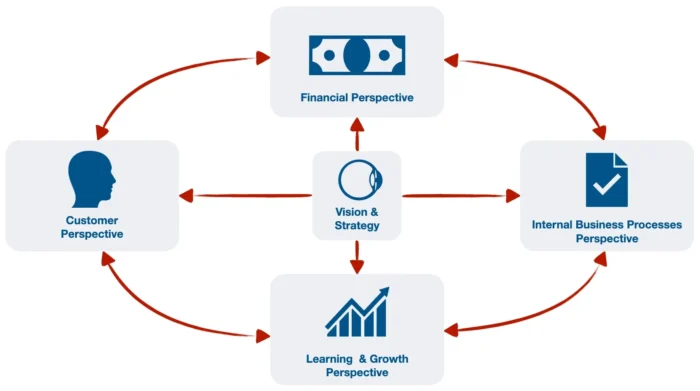
1. Financial Perspective: How Do We Look to Shareholders?
This first balanced scorecard perspective focuses on traditional financial measures and uses operating costs, revenue growth, and return on investment metrics. The financial perspective aims to answer the question: How will my company succeed financially? The focus is on profitability, growth, and shareholder value.
2. Customer Perspective: How Should We Appear to Our Customers?
This perspective centers on customer satisfaction, market share goals, and customer retention rates. It examines the business from the customer’s point of view and seeks to answer, “To achieve our vision, how should we appear to our customers?” Organizations often use surveys or other feedback mechanisms to understand customer needs and expectations.
3. Internal Business Processes Perspective: What Must We Excel at?
This perspective focuses on internal operational processes and aims to identify the critical processes at which the company must excel to meet customer and shareholder expectations. It asks, “To satisfy our shareholders and customers, what business processes must we excel at?” Key areas might include process efficiency, quality control, or internal skills development.
For example, if you track KPIs like productivity rates, quality control measures, process execution time, etc., you can easily find bottlenecks and continuously improve your specific internal business process performance.
4. Learning and Growth Perspective: Can We Continue to Improve and Create Value?
This perspective focuses on the organization’s ability to improve, innovate, and learn – key factors in long-term success. It looks at employee training and corporate cultural attitudes related to both individual and corporate self-improvement. It asks, To achieve our vision, how will we sustain our ability to change and improve?
Key Principles and Objectives
The balanced scorecard approach is based on four key principles:
- A balanced perspective: Balanced scorecards take a balanced approach by considering multiple performance dimensions, including financial, customer, internal processes, and learning and growth. This ensures that organizations focus not only on financial outcomes but also on the drivers of future success.
- Strategy alignment: The balanced scorecard aims to align organizational activities with strategic objectives. It helps translate the organization’s strategic goals into specific KPIs and targets, ensuring that everyone in the organization understands and works towards the same strategic priorities.
- Performance measurement: The balanced scorecard provides a set of performance measures that go beyond financial metrics. It includes lagging indicators (such as financial results) and leading indicators (such as customer satisfaction or employee engagement) to provide a more holistic view of performance.
- Cascading and integration: This tool is intended to be implemented across the entire organization, from top management down to each department and individual employee. It promotes integration and alignment of goals and actions across different levels of the organization, fostering a unified approach toward achieving strategic objectives.
How to Design a Balanced Scorecard – Strategy Map?
1. Identify Your Strategic Objectives
The first step in designing a balanced scorecard is identifying the organization’s strategic objectives. These objectives should align with the overall mission and vision of the organization.
Strategic objectives can be categorized into different perspectives, such as financial, customer, internal processes, and learning and growth. Also, you must ensure that the identified objectives are specific, measurable, achievable, relevant, and time-bound (SMART) is crucial.
Combining these strategic objectives with all four perspectives is a starting point in building your strategy map.
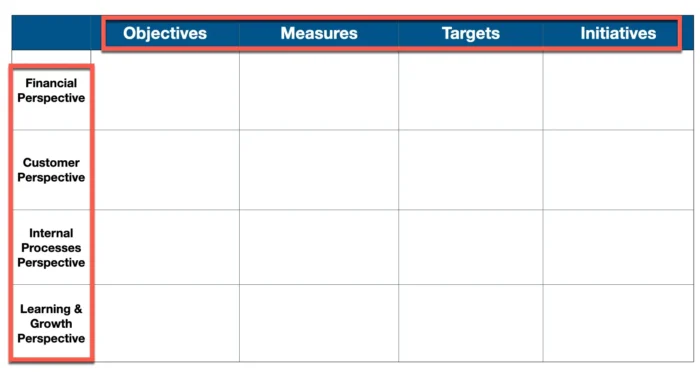
Let’s say that your strategic objectives for all four perspectives are the following:
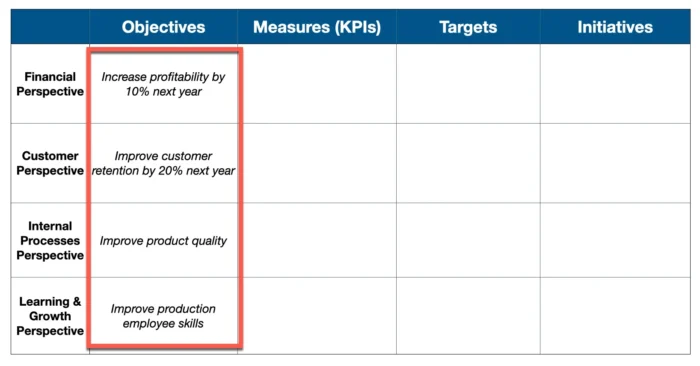
2. Develop Measures – KPIs
Once the strategic objectives are identified, the next step is to develop measures or Key Performance Indicators (KPIs) for each objective. A key performance indicator (KPI) is a quantifiable measure that helps track progress toward achieving a specific strategic objective. They provide a means of measuring performance and determining whether the organization is moving in the desired direction. KPIs should be chosen carefully to reflect the critical success factors for each objective and should be aligned with the organization’s overall strategy.
When we put the appropriate KPIs, our strategy map will look like this:

3. Targets and Initiatives
Targets and initiatives are set to define the desired level of performance for each KPI. What you want to achieve or targets specify the desired outcome or level of performance to be achieved within a specific time frame. Initiatives, however, outline the actions and projects that must be implemented to reach the targets.
Targets and initiatives should be realistic, challenging, and aligned with the organization’s strategic objectives. They should also be reviewed and updated periodically to ensure their relevance and effectiveness.
When we put the targets and initiatives, the map will look something like this:
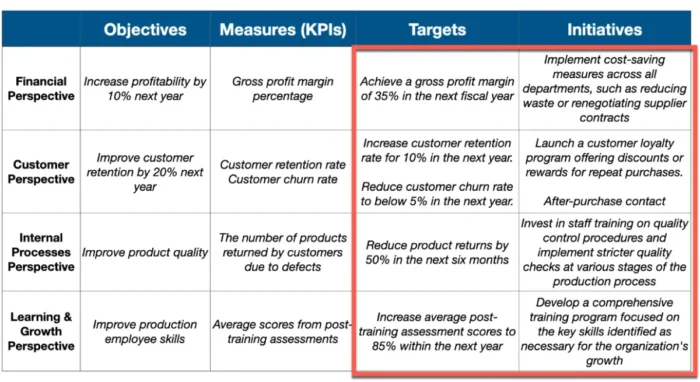
Also, the balanced scorecard must be cascaded throughout the organization to ensure alignment and accountability. This involves translating the strategic objectives, KPIs, targets, and initiatives from the corporate level to individual departments and employees. Each level of the organization should have its own scorecard that reflects how its activities contribute to the overall strategic objectives.
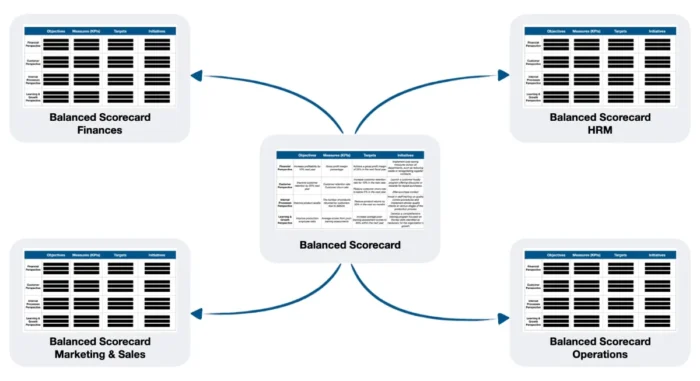
Cascading the scorecard helps create a clear line of sight between individual performance and organizational success, fostering a unified approach toward achieving strategic goals.
How to Implement the Balanced Scorecard?
1. Ensure Strong Leadership Support and Commitment
Successful implementation of the balanced scorecard requires strong leadership support and commitment. Leaders need to understand the benefits of the balanced scorecard and champion its adoption within the organization. They should actively participate in the design and development of the scorecard and demonstrate their commitment to its implementation. With strong leadership support, your business can ensure that the balanced scorecard becomes a priority and receives the necessary resources and attention.
2. Ensure Effective Communication across Your Organization
Effective communication is crucial in implementing the balanced scorecard. Employees need to understand the purpose, benefits, and expectations associated with the scorecard. You should communicate clearly and consistently to all levels of your organization, ensuring employees understand how their roles contribute to the overall strategic objectives. Regular updates and feedback sessions can help address questions or concerns and foster employee engagement and buy-in.
3. Ensure KPIs are Aligned With Job Roles and Responsibilities
To maximize the effectiveness of the balanced scorecard, KPIs should be aligned with job roles and responsibilities. Each employee should clearly understand the specific measures they are accountable for and how their performance will be evaluated. This alignment ensures that employees focus on activities directly contributing to achieving strategic objectives. Regular performance discussions and feedback sessions can help employees understand their progress and areas for improvement.
4. Integrate Scorecards Into the Organization’s Performance Management System
To ensure the sustainability of the balanced scorecard, it should be integrated into the organization’s performance management systems. This includes incorporating the scorecard into performance appraisal processes, goal setting, and performance feedback mechanisms. You can create a seamless and continuous performance management cycle by integrating the scorecard into existing systems. This integration also enables you to track progress, provide timely feedback, and align rewards and recognition with scorecard achievements.
How to Use the Balanced Scorecard for Strategic Decision-Making?
A balanced scorecard is valuable for monitoring performance and identifying variances from the desired targets. Regularly tracking the KPIs and comparing them against the established targets allows you to gain insights into areas where performance falls short or exceeds expectations. This monitoring process allows managers to identify potential issues or opportunities early on and take appropriate actions to address them.

In addition to monitoring individual KPIs, the balanced scorecard enables you to analyze performance trends and patterns over time. By examining the data collected from the scorecard, managers can identify patterns, correlations, and trends that provide valuable insights into the effectiveness of their strategies and initiatives. This analysis helps identify areas of improvement, areas of strength, and potential areas for innovation or optimization.
When variances or performance gaps are identified through the balanced scorecard, organizations can initiate corrective actions to address these issues. By analyzing the root causes of underperformance or identifying areas for improvement, managers can develop action plans and implement changes to close the gaps. The balanced scorecard facilitates a systematic approach to continuous improvement by providing a clear framework for identifying, prioritizing, and addressing performance issues.
Also, you can align resource allocation with strategic priorities. By evaluating the KPIs and identifying areas of high strategic importance, you can allocate resources, such as budget, personnel, and technology, to support achieving strategic objectives. This alignment ensures that resources are allocated strategically, focusing on areas that impact overall organizational performance most.
Related: Real-life Organizational Decision-Making Examples
Benefits of a Balanced Scorecard (BSC)
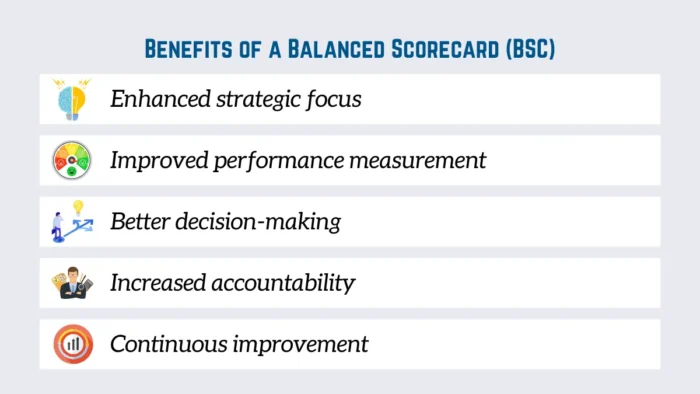
Implementing a balanced scorecard can bring several benefits to your company:
- Enhanced strategic focus: The balanced scorecard can help you to clarify and communicate your strategic goals, ensuring everyone understands and works towards the same objectives. It provides a clear framework for aligning activities with the strategic direction.
- Improved performance measurement: Using this tool will provide you with a more comprehensive and balanced view of performance by incorporating traditional financial performance measures and non-financial measures. It enables you to track progress in key areas and identify critical areas for improvement.
- Better decision-making: The balanced scorecard provides you as a decision-maker with comprehensive performance measures reflecting the organization’s strategic priorities. This enables informed decision-making based on broader factors beyond just financial outcomes.
- Increased accountability: Using the tool, you can easily assign responsibility for specific performance measures to different individuals or departments. In such a way, you will promote accountability and encourage a results-oriented culture.
- Continuous improvement: The tool encourages you to regularly review and update your measures of performance, targets, and initiatives to promote a culture of continuous improvement and adaptation to changing circumstances.
How to Overcome Challenges in Implementing the Balanced Scorecard?
Let’s look at some challenges in implementing BSC and how to overcome them:
1. Resistance to Change

One of the main challenges in implementing the balanced scorecard is resistance to change and cultural barriers within the organization. Implementing a new performance measurement system requires a shift in mindset and behavior or some organizational changes that can cause employee resistance. To overcome this challenge, you must effectively communicate the benefits of the balanced scorecard, involve employees in the design process, provide training and support, and create a continuous improvement and learning culture.
You want to engage your employees early in the process. Involving employees from different levels and functions in the design and development of the scorecard can enhance ownership, understanding, and commitment. This can be achieved through workshops, focus groups, and regular communication channels that allow employees to provide input, share ideas, and understand how their contributions align with the strategic objectives. Engaged employees are more likely to embrace the scorecard and actively work toward its success.
2. Accuracy and Reliability of the Data Used to Measure Performance
Another challenge in implementing the balanced scorecard is ensuring the accuracy and reliability of the data used to measure performance. You must establish robust data collection and reporting processes to ensure that the data used for performance measurement is accurate, relevant, and timely. This may involve implementing data validation procedures, investing in technology infrastructure, and providing training to employees responsible for data collection and reporting.
On the other side, you must ensure the continued relevance and effectiveness of the balanced scorecards. So, it is essential to regularly review and update them. The business environment is dynamic, and strategies may evolve over time. You should establish a process for periodically reviewing the KPIs, targets, and initiatives to ensure they remain aligned with the changing strategic priorities. This review process should involve key stakeholders and incorporate feedback from employees, customers, and other relevant parties. Regular updates to the scorecard will help organizations stay agile and responsive to emerging challenges and opportunities.
3. Balance Short-term and Long-term Objectives
Balancing short-term and long-term objectives can be challenging when implementing a balanced scorecard. While the scorecard provides a comprehensive view of performance, you must still ensure that they do not focus solely on short-term financial performance at the expense of long-term strategic goals. This requires careful consideration and alignment of KPIs and targets to balance immediate financial performance and the drivers of long-term success.
4. Integration With Other Management Systems Inside the Company
The balanced scorecards should be integrated with other organizational management systems and processes for maximum effectiveness. This integration ensures that the scorecard is not seen as a stand-alone initiative but as part of the overall management framework. You should align the scorecard with performance appraisal systems, goal-setting processes, and strategic planning activities.

